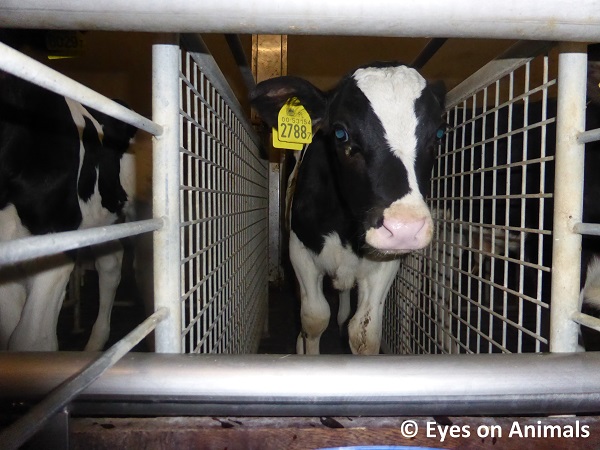Calf Season
It's calf season in Ireland. It's actually calf season in Ireland all year round, but the bulk of the two-week-old, unweaned calves sent to Europe's veal industry are shipped between February and April.
The calves are separated from their mothers at birth. They are all male, taken from the dairy industry and loaded on to trucks which then board ferries for Europe.
A typical ferry journey from Rosslare in Ireland to Cherbourg in France on a ro-ro ferry takes around 18 hours. Prior to that, the calves could have spent around five hours travelling in cramped conditions on the truck and around four hours waiting in the truck in port.
Typically, they aren't fed during that time. They would need to be shown how to feed from water dispensers fitted on the trucks. Instead, they often arrive thirsty and exhausted in France. With only a sucking reflex, they could not graze on grass even if they were ever to see some in the time before their slaughter.
Nicola Glen from Eyes on Animals in the U.K. explains the animal welfare concerns the organization raised after it trailed 23 Irish livestock trucks. “The watering facilities in the trucks are totally inadequate for calves, as they are not positioned correctly, they are not designed to work with the calf's suckling technique, and they do not actually get into the correct stomach of the calf, causing diarrhea. The fluid enters the not yet mature forestomachs (rumen, reticulum and omasum) of the calf instead of the fourth stomach (abomasum) which is fully developed.”
Veterinarian Dr. Johan Beck-Friis, Secretary General of The Swedish Association for the Protection of Animals, has documented his concerns about the trade: “Sea transports can cause several animal welfare problems, in particular related to ventilation in ferries. To minimize negative effects, livestock vehicles should be loaded last and unloaded first, and be parked in the hold near extractor fans with the ventilation openings completely opened. The longer the journey, the higher the risks for affected calf health.
“High temperatures in transport vehicles often cause poor welfare and mortality. The effects are worse if humidity is also high, a common condition in vehicles especially those which are not well ventilated.”
He notes the problem of refrigerated vehicles parked close by and running their diesel generators continuously, leading to the production of diesel fumes, has already been highlighted in an E.U. report.
Additionally, he stated: “Calves, up to at least three months old, prefer to lie down for at least a substantial part of the journey. They therefore need enough space to do this comfortably, which is a common shortcoming in long distance animal transportation.
“Further problems encountered with sea travel are travel sickness, high noise levels in the ship and poor lighting. When the ships are rolling and pitching in the sea, the lorries are moving accordingly. Particularly in the upper decks of lorries on the main deck the forces are very strong and the animals can develop motion or travel sickness. In the parking decks of the ferries the noise levels can be particularly high.”
Added to the travel time to get to Europe is the continuation of the journey to a designated control post where the calves are unloaded, fed and rested. From there, they may be sent on to Spain, the Netherlands, Italy, Germany or Belgium: so journeys can last up to 50 hours.
Eyes for Animals and French animal welfare organization L214 filmed the violent treatment of calves in a French control post last year. Hungry and scared, the calves were handled roughly. Some were hit, pulled by their ears or kicked. One calf was pushed to the ground and repeatedly jumped on. "These control posts are supposed to be places of rest for the calves but in reality, and shown in our video, there are so many calves that it is impossible for them to all lie down to rest and digest the milk replacer. Calves need to be settled to digest their food," says Glen.
Her concerns for animal welfare continue throughout the calves' lives. At fattening facilities, the calves are put straight into individual pens for eight weeks. Around three to four percent die within the first fortnight. “The calves cannot interact with one another, no enrichment. They have very little room to turn around, if at all, they are on concrete floors with slats so the mess drops down into a guttering below. They are housed indoors throughout their short miserable lives, so the only time they see daylight is when they are transported to the slaughterhouse.”

Last year, L214 went under cover into a slaughterhouse and released video footage showing calves that showed signs of consciousness before and after being suspended from the slaughter line. It also showed a sawing motion being used to cut their throats, a practice that increases the pain experienced by the animal. Calves were also able to see others being bled before they were slaughtered themselves.
Last year, Compassion in World Farming Ireland sent a petition with over 90,000 signatures to Irish Ferries and Stena Line, calling for the companies to follow P&O Ferries lead to not ship any livestock intended for fattening and slaughter. L214 and Eyes on Animals are also running a petition against the transport of unweaned calves which will be sent to the European Commission.
